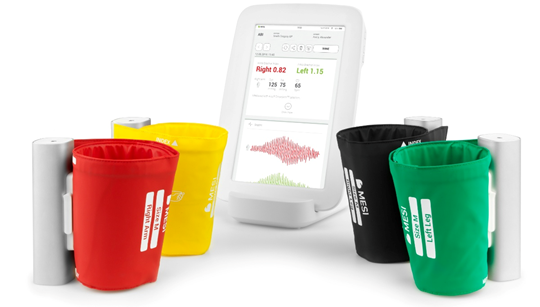
Accurate diagnosis of peripheral artery disease (PAD) can be a challenging task, even for seasoned physicians with years of practical experience. That statement is only true if a physical examination or similar approach is used instead of modern diagnostic devices, which offer exceptional accuracy and reliability in comparison with the aforementioned “hands-on” method. Though, not all diagnostic tools are equal.
The prevalence of PAD is growing rapidly, and it is estimated there were 236 million patients with the disease in 2015, up from 202 million in 2010, and this trend is expected to continue [1, 2]. Of course, this should come as no surprise as PAD has many of the same risk factors as other cardiovascular diseases (CVDs), specifically coronary artery disease (CAD), the greatest killer amongst them. The main underlying pathophysiology is the same—atherosclerosis.
One of the most important risk factors for atherosclerosis is diabetes, which unsurprisingly affects many patients with PAD. At least 20% of all patients with diabetes also have PAD, but that number is misleading as it includes only those with a symptomatic form of the disease [4].
Only about 10% of patients with PAD have typical symptoms (intermittent claudication), 40% are entirely asymptomatic and the rest (50%) have atypical symptoms that could be attributed to other diseases [5, 6]. Diabetics are particularly at risk for intermittent claudication: males are 3.5 times more at risk, while females are 8.6 times more at risk than non-diabetics of respective gender [7].
The harmful effects of diabetes on PAD don’t end there. Namely, diabetes mellitus is closely connected with the most serious advanced form of PAD, critical limb ischaemia (CLI). Prevalence rates of diabetes in patients with CLI go as high as 50% and those individuals suffer worse outcomes when it comes to lower-extremity amputations and mortality than non-diabetics [8, 9, 10]. Patients with both diseases are in general at a significantly higher risk (5 to 15 times) than those with only PAD [11]. Diagnosis of CLI on its own is associated with very high amputation rates and mortality [12, 13, 14, 15, 16].
Diabetes may be an especially difficult condition to treat and manage, but the same could not be said for many other risk factors of PAD, thus significantly decreasing the incidence and severity of the disease. Smoking is a prime example, both since it is the second most important risk factor and that its harmful effects can be greatly or completely reduced, if the patient wants to kick the habit and is given proper support. Tobacco smoking greatly increases the risk for PAD, particularly in female smokers who are 20 times more at risk than women who have never smoked [17, 18]. Smoking cessation is highly beneficial for many other reasons besides lowering the risk of CVDs, but still carries a residual risk in those with PAD: former smokers are at 2.6 times greater risk than individuals who have never smoked [19].
Other notable risk factors include chronic kidney disease (CKD), CAD and a history of stroke, transient ischaemic attacks (TIA) and myocardial infarction (MI) [20, 21, 22, 23, 24, 25, 26]. At risk are also individuals with hyperlipidaemia, hypertension, unhealthy weight, chronic obstructive pulmonary disease or COPD and with a family history of PAD [27, 28, 29, 30, 31].
However, a proper treatment procedure can be formulated only after a definite diagnosis has been made. Physical examination is a possibility, but it is unreliable, especially if performed by an untrained examiner [32]. An incomparably better diagnostic method is angiography, which is extremely accurate, but is complex, time-consuming and expensive and may even be inappropriate for some patients [33, 34]. The second-best option is the ABI assessment, which can be performed in more than one way.
The MESI mTABLET ABI diagnostic tool
The standard diagnostic method for screening for PAD and assessing its severity is the Doppler method, which entails the use of a Doppler probe and a sphygmomanometer: the examiner measures systolic blood pressure (BP) at the upper arm (brachial artery) and at the ankle (tibial and dorsalis pedis artery) and manually calculates the ABI. A relatively simple diagnostic procedure, but one whose accuracy is predicated on the examiner’s experience and skill [35]. It also takes considerable time to perform, up to 30 minutes—in comparison with 1 minute for a far more versatile oscillometric-plethysmographic device [36, 37]. But there are even better, more versatile devices available.
The MESI mTABLET ABI is the perfect example as it offers far more than just accurate diagnosis and assessment of PAD. It combines the ABI diagnostic module with the MESI mTABLET’s intuitive user interface and integrated support for an electronic health record (EHR) management and sharing system, giving physicians and other healthcare professionals a powerful tool in their battle against PAD. On top of that, the ABI diagnostic module’s pressure cuffs are wirelessly connected to the MESI mTABLET for even greater ease of use. The user-friendliness of this diagnostic tool is only rivalled by the incorporated advanced technology, including 3CUFF™ technology that allows simultaneous measurement of brachial and ankle pressures and the PADsense™ algorithm for detection of severe PAD that is often overlooked by other comparable devices on the market.
There are many diagnostic devices for diagnosing PAD, but few if any as versatile as the MESI mTABLET ABI, which offers accurate ABI assessment, instant saving of results in the patient’s EHR and fast and easy sharing of data with other healthcare professionals.
[1] https://www.thelancet.com/journals/lancet/article/PIIS0140-6736(13)61249-0/fulltext
[2] https://www.thelancet.com/journals/langlo/article/PIIS2214-109X(19)30255-4/fulltext
[3] https://www.who.int/healthinfo/global_burden_disease/GHE2016_Deaths_WBInc_2000_2016.xls
[4] https://care.diabetesjournals.org/content/26/12/3333
[5] https://jamanetwork.com/journals/jama/fullarticle/194205
[6] https://jamanetwork.com/journals/jama/fullarticle/194250
[7] https://www.sciencedirect.com/science/article/pii/S0735109705028627
[8] https://www.ncbi.nlm.nih.gov/pubmed/17306950/
[9] https://www.jvascsurg.org/article/S0741-5214(06)02258-0/fulltext
[10] https://journals.sagepub.com/doi/abs/10.1191/1358863x03vm511oa
[11] https://www.ncbi.nlm.nih.gov/pmc/articles/PMC4499529/
[12] https://www.ncbi.nlm.nih.gov/pubmed/16325694
[13] https://www.ncbi.nlm.nih.gov/pubmed/15525738
[14] https://www.jvascsurg.org/article/S0741-5214(15)01625-0/fulltext
[15] https://www.jvascsurg.org/article/S0741-5214(06)02296-8/fulltext
[16] https://www.ejves.com/article/S1078-5884(11)60009-9/fulltext
[17] https://heart.bmj.com/content/100/5/414
[18] https://www.ncbi.nlm.nih.gov/pmc/articles/PMC3111942/
[19] https://www.sciencedirect.com/science/article/pii/S0741521404011413
[20] https://www.ncbi.nlm.nih.gov/pubmed/17626985
[21] https://www.ncbi.nlm.nih.gov/pubmed/15125482
[22] https://www.ncbi.nlm.nih.gov/pubmed/7658111
[23] https://www.elsevier.es/es-revista-archivos-cardiologia-mexico-293-articulo-prevalence-risk-factors-associated-with-S1405994017300113
[24] https://www.ncbi.nlm.nih.gov/pubmed/17668260
[25] https://onlinelibrary.wiley.com/doi/full/10.1111/j.1538-7836.2006.02225.x
[26] https://www.ahajournals.org/doi/full/10.1161/01.CIR.0000114519.75433.DD
[27] https://openres.ersjournals.com/content/4/4/00086-2018
[28] https://pdfs.semanticscholar.org/0594/15ad0ba1e52dc181e40468283e8513542cb9.pdf
[29] https://www.ncbi.nlm.nih.gov/pubmed/15579058
[30] https://academic.oup.com/aje/article/174/9/1036/168550/
[31] https://www.ncbi.nlm.nih.gov/pmc/articles/PMC3215334/
[32] https://www.ncbi.nlm.nih.gov/pmc/articles/PMC2497570/
[33] https://jasn.asnjournals.org/content/17/9/2359
[34] https://academic.oup.com/ndt/article/21/4/1104/1932577
[35] https://www.ncbi.nlm.nih.gov/pubmed/8156330/
[36] https://www.ncbi.nlm.nih.gov/pmc/articles/PMC4973721/
[37] http://www.heraldopenaccess.us/fulltext/Non-Invasive-Vascular-Investigation/Comparison-of-Ankle-Brachial-Index-ABI-Measurement-between-a-New-Oscillometric-Device-MESI-ABPI-Md-and-the-Standard-Doppler-Method.php
